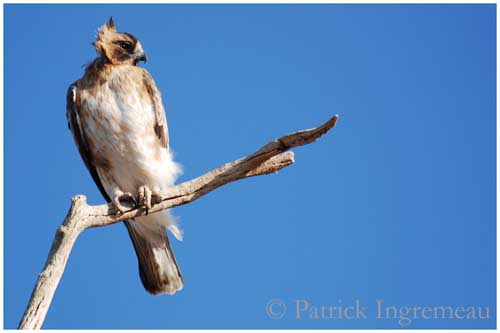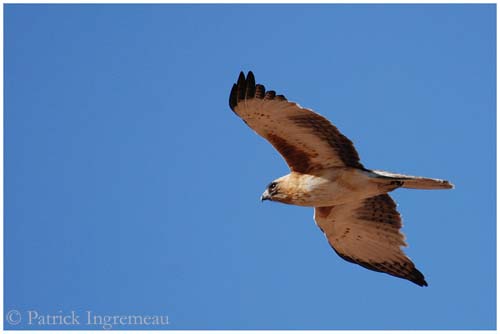
Little Eagle
Hieraaetus morphnoides
Accipitriforme Order – Accipitridae Family
BIOMETRICS:
Length : 45-55 cm
Wingspan : 100-136 cm
Weight : 815 gr
LONGEVITY : Up to 10 years
DESCRIPTION:
Little Eagle is a small eagle native to Australia. This eagle can be found in both light and dark morph.
Little Eagle has varied plumage from pale to dark brown. On the upperparts, we can see a pale, incomplete M, visible from some distance.
Dark morph shows deep shades of brown on head and upperparts, whereas birds in light phase show whitish areas on greater wing coverts.
On the underparts, we can also see a pale M-shaped band. Its long and broad wings show dark flight feathers and black fingers.
Throat and upper breast are whitish, streaked with reddish-brown. Belly and vent are whitish, slightly washed with rufous.
Underparts can be darker in dark morph. Upper tail is fairly pale brown with narrow darker bands. Undertail is paler, with the same dark bands.
Head is pale reddish-brown. Forehead and face are dark brown. On the crown, it has short crest. Base of upper mandible is whitish. Hooked bill is dark grey-blue, with paler cere. Eyes are brown. Legs are very well feathered. Talons are yellowish with black claws.
Both sexes are similar, with female larger than male.
REPRODUCTION:
Breeding season occurs from August to October, but earlier in southern parts of the range.
Little Eagle breeds in open woodlands or along watercourses, rarely in isolated tree.
Nest is made with twigs and small branches. It is bowl-shaped, and lined with green leaves.
Female lays 1 to 3 eggs. Incubation lasts about 37 days, shared by both parents, but mainly by female. Male incubates when female leaves the nest for eating the food brought for her by its mate. Female broods the chicks and feeds them with food brought at nest by male. She gives them small pieces bill to bill.
Young fledge about 57 to 60 days after hatching.
DIET:
Little Eagle feeds mainly on rabbits and other small mammals, birds and insects.
PROTECTION / THREATS / STATUS:
Little Eagle’s populations are secure in Australia, but this species is uncommon.
They are disturbed by human developments, but this species may benefit from clearing, giving other feeding areas.
Fr: Aigle nain
All : Kaninchenadler
Esp : Aguililla Australiana
Ital : Aquila minore australiana
Nd : Australische Dwergarend
Russe : Австралийский ястребиный орёл
Patrick Ingremeau
TAMANDUA
Text by Nicole Bouglouan
Sources:
HANDBOOK OF THE BIRDS OF THE WORLD Vol 2 by Josep del Hoyo-Andrew Elliot-Jordi Sargatal - Lynx Edicions - ISBN: 8487334156
BIRDS OF ASIA AND AUSTRALIA by David Alderton – Southwater - ISBN : 184215978X
Wikipedia (Wikipedia, The Free Encyclopedia)
Birds in backyards (Birds Australia and Australian Museum)

VOICE:
Little Eagle can be very vocal during breeding season, giving whistles, chatters, whines and squeals.
HABITAT:
Little Eagle lives mostly in open woodlands, grasslands and arid areas. It usually avoids dense forests, and can be found from sea level up to 1900 metres of elevation. It is usually associated with watercourses in woodlands and open forests.
RANGE:
Little Eagle is found in Australia and New Guinea, and in some Indonesian islands.
BEHAVIOUR:
Little Eagle hunts during the day. It soars before to approach with silent flight. When prey is selected, it performs flapping flight before to dive from about 100 metres of height. It can hunt as in bushes or in open areas.
It hunts mainly birds and rabbits, small mammals and insects. It also hunts from high exposed perch, searching for preys. Preys are taken from the ground, in shrub or in canopy.
Little Eagle is partially migratory and can perform some dispersion. Young disperse more than adults which usually are sedentary in their habitat.
FLIGHT:
Little Eagle soars, performs flapping flight and dives for hunting.
